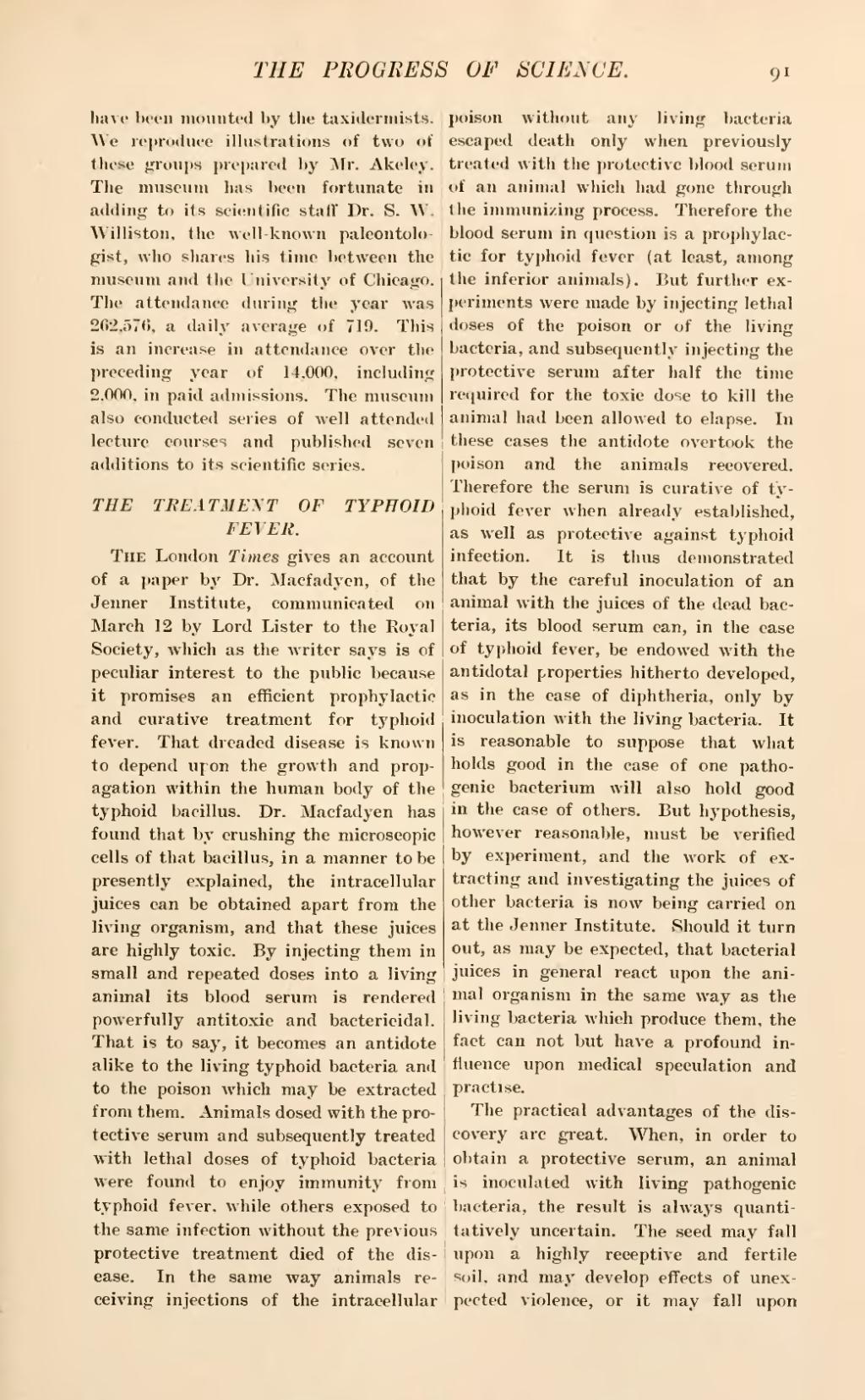have been mounted by the taxidermists. We reproduce illustrations of two of these groups prepared by Mr. Akeley. The museum has been fortunate in adding to its scientific staff Dr. S. W. Williston, the well-known paleontologist, who shares his time between the museum and the University of Chicago. The attendance during the year was 262,570, a daily average of 719. This is an increase in attendance over the preceding year of 14,000, including 2.000, in paid admissions. The museum also conducted series of well attended lecture courses and published seven additions to its scientific series.
THE TREATMENT OF TYPHOID FEVER.
The London Times gives an account of a paper by Dr. Macfadyen, of the Jenner Institute, communicated on March 12 by Lord Lister to the Royal Society, which as the writer says is of peculiar interest to the public because it promises an efficient prophylactic and curative treatment for typhoid fever. That dreaded disease is known to depend upon the growth and propagation within the human body of the typhoid bacillus. Dr. Macfadyen has found that by crushing the microscopic cells of that bacillus, in a manner to be presently explained, the intracellular juices can be obtained apart from the living organism, and that these juices are highly toxic. By injecting them in small and repeated doses into a living animal its blood serum is rendered powerfully antitoxic and bactericidal. That is to say, it becomes an antidote alike to the living typhoid bacteria and to the poison which may be extracted from them. Animals dosed with the protective serum and subsequently treated with lethal doses of typhoid bacteria were found to enjoy immunity from typhoid fever, while others exposed to the same infection without the previous protective treatment died of the disease. In the same way animals receiving injections of the intracellular poison without any living bacteria escaped death only when previously treated with the protective blood serum of an animal which had gone through the immunizing process. Therefore the blood serum in question is a prophylactic for typhoid fever (at least, among the inferior animals). But further experiments were made by injecting lethal doses of the poison or of the living bacteria, and subsequently injecting the protective serum after half the time required for the toxic dose to kill the animal had been allowed to elapse. In these cases the antidote overtook the poison and the animals recovered. Therefore the serum is curative of typhoid fever when already established, as well as protective against typhoid infection. It is thus demonstrated that by the careful inoculation of an animal with the juices of the dead bacteria, its blood serum can, in the case of typhoid fever, be endowed with the antidotal properties hitherto developed, as in the case of diphtheria, only by inoculation with the living bacteria. It is reasonable to suppose that what holds good in the case of one pathogenic bacterium will also hold good in the case of others. But hypothesis, however reasonable, must be verified by experiment, and the work of extracting and investigating the juices of other bacteria is now being carried on at the Jenner Institute. Should it turn out, as may be expected, that bacterial juices in general react upon the animal organism in the same way as the living bacteria which produce them, the fact can not but have a profound influence upon medical speculation and practise.
The practical advantages of the discovery are great. When, in order to obtain a protective serum, an animal is inoculated with living pathogenic bacteria, the result is always quantitatively uncertain. The seed may fall upon a highly receptive and fertile soil, and may develop effects of unexpected violence, or it may fall upon
